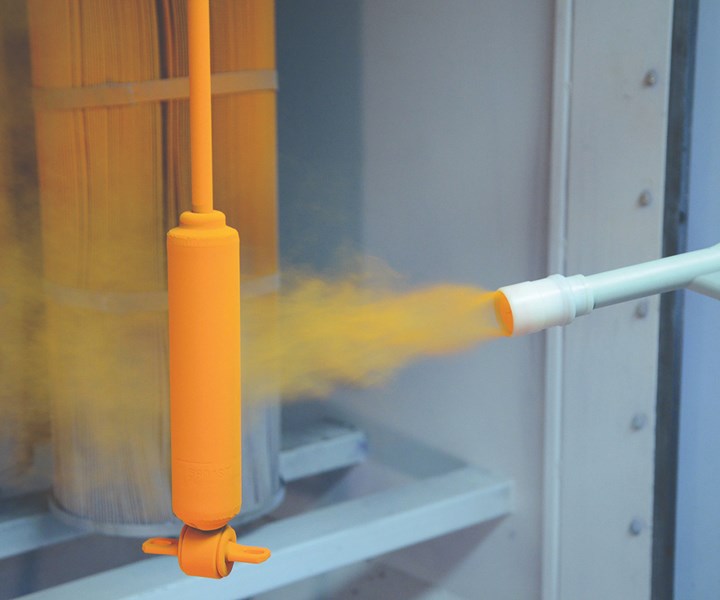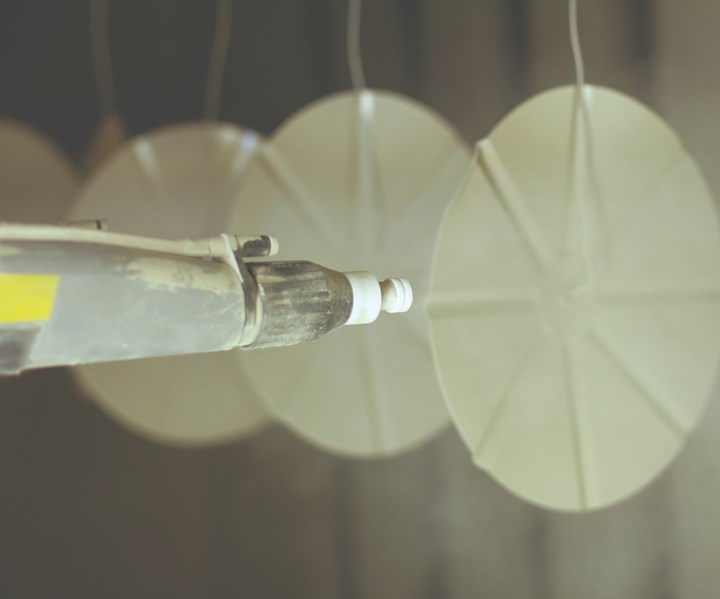Powder Coating Spray Guns
Featuring electrostatic spray guns, systems, nozzles and more.
Believe it or not, powder coating has been around since the 1950s—but it has only been within the last 25 years that powder coating has seen dramatic growth, making it one of the most popular finishes for several industries. Powder Coating offers one of the most economical, longest-lasting and most color-durable quality finishes available in todays market. Automotive, appliance, architecture, agriculture and so many other industries have seen the benefits of powder and use powder in thousands of products.
When it comes to applying powder, there are basically two distinct processes: fluidized bed or spraying technique. In fluidized bed powder coating, heated parts can be dipped directly into a container of fluidized powder or passed through an electrically charged cloud of powder. Spray application techniques can be broken down into several categories: corona guns, tribo guns, flame spray guns, corona bells, and tribo discs,
Functions of the electrostatic powder spray gun are to shape and direct the flow of powder; to control the pattern size, shape and density of powder; to impart the electrostatic charge to the powder being sprayed and control the deposition of powder onto the parts being sprayed.
This month’s showcase focuses on the several types of guns, as well as accessories and current trends with application equipment.

Manual vs. Automatic
Manual guns can be used in stand-alone units, applications not requiring automatic guns, or with automatic systems that are generally used for difficult-to-reach and/or complex parts.
Since the hand painter uses the spray gun for long periods of time, the flexibility, weight, efficiency and durability of the spray gun are important. Manual guns are typically used for lower-production application, while automatic guns are useful for high-production processes. Upgrading or purchasing an automatic system can increase transfer efficiency and reduce reclaim, but these systems can be costly. Automatic guns spray an area blindly—regardless of whether there is a part there or not. So having products densely loaded onto the conveyor is crucial for attaining maximum benefit. There are triggering systems that can be used with automatic guns, which use photo eyes or light curtains to identify when a part is present to be coated, triggering the guns off/on. The triggering system can add as much as 50% to your purchase cost. Also, an automatic system is not completely self-sufficient and still requires someone to provide powder, answer alarms, monitor and supervise the equipment—so again, you need to think if the cost of such a system is worth it for your application.

Types of Electrostatic Guns
Tribo guns charge an epoxy powder as a result of friction that occurs when powder particles rub a solid insulator or conductor inside the gun. The resulting charge is accomplished by stripping electrons from the powder, producing positively charged powder. Because there is no actual electrostatic field, the charged particles of powder migrate toward the grounded part and are free to deposit in a very thin coating to a part and can coat tight, recessed areas. Tribo guns have two weaknesses though. First, it coats at half the speed of a corona-charge powder gun and second, it works best with epoxy powders.
The tribo disk features a non-rotating disk positioned vertically inside an Wloop, and parts are conveyed through the loop as the disk oscillates up and down, applying overlapping layers of powder coating on the parts’ surface. The tribostatic charging method is employed, and the disk forms a uniform, horizontal spray pattern of about 2.5 feet in diameter.
Corona spray guns are the most common in the application process. They can generate a high-voltage, low-amperage electrostatic field between the electrode and the product being coated. Powder particles that pass through the ionized electrostatic field at the tip of the electrode become charged and are deposited on the electrically grounded surface of the part. Corona guns have a few disadvantages. First, the corona gun makes it difficult to cover recessed areas and tight corners with powder—using a high-quality powder that retains the high-voltage charge best controls this problem. Second, recoating a part that has already been cured is difficult with a corona spray gun.
Corona bells are used in applications where large flat areas need to be coated at a high rate of speed. If you have to spray a lot of powder in a short period of time onto a relatively flat surface, then these are the preferred application devices. Typical bell applications are automotive car bodies and appliance outer shells. The charging technique is the same as used in corona guns, with similar effect.
Flame spray powder coating equipment is typically used to coat large objects using thermoplastic powders where using an oven is impossible. This equipment ignites combustible gasses at the gun tip. The resultant heat combines with thermoplastic powder, melting it as it is propelled to the part’s surface. This technique is used where lower coating costs are desired and a lower coating quality can be tolerated. There are several risks with flame spray including extraction of dust and fumes and fire or explosion of dust and fumes.
Quick Color Changes
Recent and ongoing developments in the equipment for powder application have significantly reduced the time, effort and capital cost required for color changes. Efforts to increase application efficiency, streamline the powder delivery system and redesign the booth have all contributed to speeding up the color change process. Properly designed, operated and maintained powder systems can change colors in minutes. Powder booths with plastic walls that repel rather than attract the powder, curved booth walls to discourage powder accumulation, automated belts and sweepers that brush powder particles on the floor to recovery systems and powerful bursts of air through the pumps and guns to clean the system have helped reduce color change operations, sometimes to 10 minutes or less. Some high-production powder systems apply dozens of colors, with up to 20 color changes per day.
Accessories
Selecting proper gun attachments and accessories is another important consideration in powder delivery systems. There are a host of different tips available by all manufacturers for all equipment. There are flat spray nozzles, extension tips, various deflector sizes and shapes. Each of these tips serves different purposes and creates different cloud patterns for penetrating different areas. Extension lances will help you get into recessed areas.
There are several choices when it comes to selecting powder coating application equipment. You need to take into consideration the parts that need to be coated, the type of coating that is desired, the requirements of that coating as well as financial requirements in order to find the right equipment for your process.
Featured Suppliers
Gema | Karajen Corp - Booth Box | Parker Ionics | Wagner Industrial Solutions
Supplier Database
View All Powder Coating Equipment Suppliers
Related Content
Products Finishing Reveals 2023 Qualifying Top Shops
Each year PF conducts its Top Shops Benchmarking Survey, offering shops a tool to better understand their overall performance in the industry. The program also recognizes shops that meet a set of criteria to qualify as Top Shops.
Read MoreProducts Finishing Reveals 2024 Qualifying Top Shops
PF reveals the qualifying shops in its annual Top Shops Benchmarking Survey — a program designed to offer shops insights into their overall performance in the industry.
Read MoreMasking Solutions Provider CFS Dramatically Expands Capabilities and Capacity
Custom Fabrication & Supplies (CFS) completed a new plant expansion packing 10 times the capacity into twice the space. It dramatically enhances the supplier’s custom capabilities to provide extremely precise and cost-effective masking solutions.
Read MoreReduced, Reused and Recycled Powder Coatings Are the Future
They say necessity is the mother of invention, and with millions of pounds of powder coating going into landfills a year, these two companies have found novel approaches to dealing with this waste stream.
Read MoreRead Next
Episode 45: An Interview with Chandler Mancuso, MacDermid Envio Solutions
Chandler Mancuso, technical director with MacDermid Envio discusses updating your wastewater treatment system and implementing materials recycling solutions to increase efficiencies, control costs and reduce environmental impact.
Read MoreDelivering Increased Benefits to Greenhouse Films
Baystar's Borstar technology is helping customers deliver better, more reliable production methods to greenhouse agriculture.
Read MoreA ‘Clean’ Agenda Offers Unique Presentations in Chicago
The 2024 Parts Cleaning Conference, co-located with the International Manufacturing Technology Show, includes presentations by several speakers who are new to the conference and topics that have not been covered in past editions of this event.
Read More










.jpg;maxWidth=300;quality=90)










